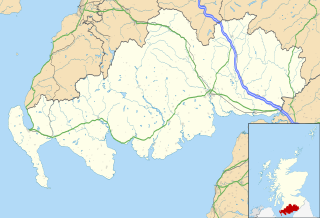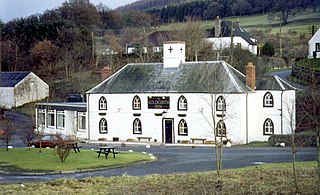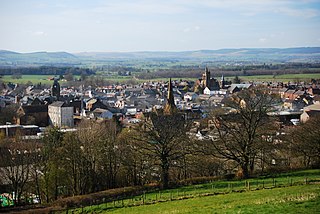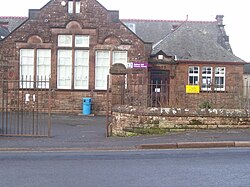
Dumfries is a market town and former royal burgh in Dumfries and Galloway, Scotland, near the mouth of the River Nith on the Solway Firth, 25 miles (40 km) from the Anglo-Scottish border. Dumfries is the county town of the historic county of Dumfriesshire.

Dumfries and Galloway is one of the 32 unitary council areas of Scotland, located in the western part of the Southern Uplands. It is bordered by East Ayrshire, South Ayrshire, and South Lanarkshire to the north; Scottish Borders to the north-east; the English county of Cumbria, the Solway Firth, and the Irish Sea to the south, and the North Channel to the west. The administrative centre and largest settlement is the town of Dumfries. The second largest town is Stranraer, located 76 miles (122 km) to the west of Dumfries on the North Channel coast.

Kirkcudbright is a town at the mouth of the River Dee in Dumfries and Galloway, Scotland, southwest of Castle Douglas and Dalbeattie. A former royal burgh, it is the traditional county town of Kirkcudbrightshire.

Thornhill is a village in the Mid Nithsdale area of Dumfries and Galloway, Scotland, south of Sanquhar and north of Dumfries on the main A76 road. Thornhill sits in the Nithsdale valley with the Carsphairn and Scaur range to the west and the Lowther hills to the east. It was initially a small village, planned and built in 1717 on the Queensberry Estate on the road linking Dumfries to Glasgow. The Earl of Queensberry initially named the village 'New Dalgarnock' however the name did not achieve popular approval.

Newton Stewart is a former burgh town in the historical county of Wigtownshire in Dumfries and Galloway, southwest Scotland. The town is on the River Cree with most of the town to the west of the river, and is sometimes referred to as the "Gateway to the Galloway Hills".

Dumfriesshire or the County of Dumfries or Shire of Dumfries is a historic county and registration county in southern Scotland. The Dumfries lieutenancy area covers a similar area to the historic county.
Stranraer Academy is a secondary school in Stranraer in south west Scotland. It serves the area of Stranraer, the Rhins, and parts of the Machars.
Gatelawbridge is a hamlet in the region of Dumfries and Galloway, Scotland. It is situated two and a half miles east of Thornhill and near the gorge Crichope Linn. The origin of the name is unknown though in the past the locals called it Gateley Bridge, so perhaps it takes its name from a type of bridge over the Cample River in the centre of the settlement. The river divides the parishes, with all those east of the river being in Closeburn Parish, and those west of the river being in Morton Parish.

Closeburn Castle is a privately owned tower house, probably of the 14th century, but possibly older, and is one of the oldest continually inhabited houses in Scotland. The castle is located 1 km east of the village of Closeburn, in the historical county of Dumfriesshire, 2 km south-east of Thornhill, in Dumfries and Galloway, Scotland.
St Joseph's College in Dumfries, South West Scotland, is a Roman Catholic secondary school. It began as a Catholic boys' boarding school run by Marist Brothers.

Maxwelltown High School was a state funded, six-year comprehensive secondary school in the Lochside area of Dumfries, Scotland. Founded in 1971, Maxwelltown High School was the most recently founded secondary school in Dumfries and Galloway, before merging with other schools into North West Community Campus. It had 311 pupils as of August 2012. The roll of Maxwelltown High School had been steadily declining since 2002.

Auldgirth is a village on the A76 road in Dumfries and Galloway, Scotland. Auldgirth village features 'The Auldgirth Inn' and the former Auldgirth Primary School, which closed in 2000. Originally inhabitants of Auldgirth located to the scheme, situated next to the A76, but in recent years this has expanded to the outlying areas due to rejuvenation programmes. The name Auldgirth is from Early Scots ald(e) girth, meaning 'old enclosure'. At one time it had a staffed railway station, situated one mile south of the village, just before the hamlet of Dalswinton. Carse Loch and the Friar's Carse country house hotel are located nearby.

Lockerbie is a town in Dumfries and Galloway, south-western Scotland. It is about 120 km from Glasgow, and 25 km from the border with England. The 2001 Census recorded its population as 4,009. The town came to international attention in December 1988 when the wreckage of Pan Am Flight 103 crashed there following a terrorist bomb attack aboard the flight.

Closeburn is a rural locality in the City of Moreton Bay, Queensland, Australia. In the 2021 census, Closeburn had a population of 562 people.

Closeburn is a village and civil parish in Dumfries and Galloway, Scotland. The village is on the A76 road 2+1⁄2 miles (4 km) south of Thornhill. In the 2001 census, Closeburn had a population of 1,119. Closeburn is recorded as Killosbern in 1185. The first element of the name is Gaelic cill 'cell or church'. The second element is a saint's name, but none has definitely been identified.

Kirkgunȝeon is a village and civil parish in Dumfries and Galloway, south west Scotland. The village is 10.4 miles (16.7 km) south west of Dumfries and 4.1 miles (6.6 km) north east of Dalbeattie. The civil parish is in the former county of Kirkcudbrightshire, and is bounded by the parishes Lochrutton to the north, Urr to the west, Colvend and Southwick to the south and New Abbey to the east.

Brownhill Inn, now just called Brownhill, was an inn approximately 1 mile (1.6 km) mile south of Closeburn, on the A76, which itself is about 2 miles (3.2 km) south of Thornhill, in Dumfries and Galloway, Scotland. Built in approximately 1790, this old coaching inn has undergone extensive changes, and the south side of the original property appears little changed whilst part of the inn has been demolished. The inns facilities used to include the once-extensive 12 stall livery stables on the west side of the road, but these have been sold and converted to farm buildings after the inn closed. The inn was the first changing place for horses hauling coaches from Dumfries and closed in 1850. In 1789 an Act of Parliament had been passed that enabled the building of a Turnpike from Auldgirth Bridge to Sanquhar through Closeburn Parish and the inn was built to serve the patrons of this new road. The toll road supplanted the original post road that ran via Stepends, Gateside and Shaw that may have been of Roman origins.

Sir Alister William Jack is a Scottish politician who served as Secretary of State for Scotland from 2019 to 2024. A member of the Scottish Conservatives, he served as Member of Parliament (MP) for Dumfries and Galloway from 2017 to 2024.

Dalgarnock, Dalgarno, Dalgarnoc was an ancient parish and a once considerable sized village in the Nithsdale area of Dumfries and Galloway, Scotland, south of Sanquhar and north of Dumfries that enclosed the parish of Closeburn but was annexed to Closeburn in 1606 following the Reformation, separated again in 1648 and finally re-united in 1697, as part of the process that established the Presbyterian Church of Scotland. It was a burgh of regality bordering the River Nith and Cample Water and held a popular market-tryst or fair from medieval times until 1601 when the Earl of Queensberry had them transferred to Thornhill, commemorated in song by Robert Burns, shortly before its demise and now only a remote churchyard remains at a once busy site.




















